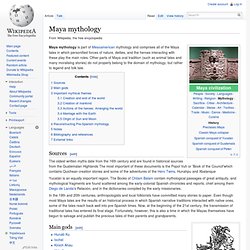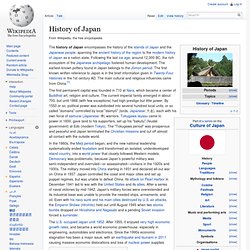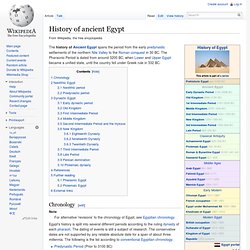

Vertical Gardening. Languages. Guitar lessons. Physics and Astronomy. Maya mythology. Maya mythology is part of Mesoamerican mythology and comprises all of the Maya tales in which personified forces of nature, deities, and the heroes interacting with these play the main roles.

Other parts of Maya oral tradition (such as animal tales and many moralising stories) do not properly belong to the domain of mythology, but rather to legend and folk tale. Sources[edit] The oldest written myths date from the 16th century and are found in historical sources from the Guatemalan Highlands The most important of these documents is the Popol Vuh or 'Book of the Council'which contains Quichean creation stories and some of the adventures of the Hero Twins, Hunahpu and Xbalanque Yucatán is an equally important region. In the 19th and 20th centuries, anthropologists and local folklorists have committed many stories to paper. Main gods[edit] Important mythical themes[edit] Creation and end of the world[edit] Creation of mankind[edit] History of Japan. The history of Japan encompasses the history of the islands of Japan and the Japanese people, spanning the ancient history of the region to the modern history of Japan as a nation state.

Following the last ice age, around 12,000 BC, the rich ecosystem of the Japanese archipelago fostered human development. The earliest-known pottery found in Japan belongs to the Jōmon period. The first known written reference to Japan is in the brief information given in Twenty-Four Histories in the 1st century AD. The main cultural and religious influences came from China.[1] The first permanent capital was founded in 710 at Nara, which became a center of Buddhist art, religion and culture. In the 1860s, the Meiji period began, and the new national leadership systematically ended feudalism and transformed an isolated, underdeveloped island country, into a world power that closely followed Western models. The U.S. occupied Japan until 1952. History of Japan.
Ancient history. Ancient history is the aggregate of past events[1] from the beginning of recorded human history to the Early Middle Ages or the Postclassical Era. The span of recorded history is roughly 5,000 years, with Sumerian Cuneiform script, the oldest discovered form of coherent writing, from the protoliterate period around the 30th century BC.[2] The term classical antiquity is often used to refer to history in the Old World from the beginning of recorded Greek history in 776 BC (First Olympiad). History of ancient Egypt. The history of Ancient Egypt spans the period from the early predynastic settlements of the northern Nile Valley to the Roman conquest in 30 BC.

The Pharaonic Period is dated from around 3200 BC, when Lower and Upper Egypt became a unified state, until the country fell under Greek rule in 332 BC. Chronology[edit] Note For alternative 'revisions' to the chronology of Egypt, see Egyptian chronology. Egypt's history is split into several different periods according to the ruling dynasty of each pharaoh. Predynastic Period (Prior to 3100 BC)Protodynastic Period (Approximately 3100–3000 BC)Early Dynastic Period (1st–2nd Dynasties)Old Kingdom (3rd–6th Dynasties)First Intermediate Period (7th–11th Dynasties)Middle Kingdom (12th–13th Dynasties)Second Intermediate Period (14th–17th Dynasties)New Kingdom (18th–20th Dynasties)Third Intermediate Period (21st–25th Dynasties) (also known as the Libyan Period)Late Period (26th–31st Dynasties) Neolithic Egypt[edit] Neolithic period[edit] Dynastic Egypt[edit]
History of ancient civilizations. Open Technology.